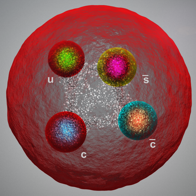Quantum Chromodynamics
Problems
practice
- The mass of the top quark is 172,570 MeV/c2 — heavier than some atoms. Identify the heaviest element that is lighter than the top quark.
- What fraction of the mass of you and me, the air, earth, oceans, and everything else we deal with in our ordinary lives is due to the strong force?
- The sigma baryons are a family of particles with two first generation quarks (u, d) and one higher generation quark (s, c, b). Top quarks probably cannot form sigma baryons since they decay before they can interact with other quarks. Sigma baryons can have a charge of −1e, 0e, +1e, or +2e.
- What combination(s) of quarks will produce a sigma baryon with a charge of −1e?
- What combination(s) of quarks will produce a sigma baryon with a charge of +0e?
- What combination(s) of quarks will produce a sigma baryon with a charge of +1e?
- What combination(s) of quarks will produce a sigma baryon with a charge of +2e?
- Two protons in a helium nucleus are separated by a typical distance of 1.2 fm. Determine…
- the electrostatic force between them. (About how big is this?)
- the gravitational force between them. (About how big is this?)
Please comment on these values.
- Why is the nuclear force between nucleons called the strong nuclear force?
- Why is the gravitational force often described as weak?
conceptual
- What is the total number of quarks in a helium nucleus consisting of 2 protons and 2 neutrons?
- Pions (π) are particles in the meson family that were proposed in 1935 as carriers of the strong force within the nucleus. Pions are made of up and down quarks and are charged or neutral. Charged pions were first detected in 1947 followed by the neutral pion in 1950.
- What combination(s) of quarks will produce a positive pion (π+)?
- What combination(s) of quarks will produce a negative pion (π−)?
- What combination(s) of quarks will produce a neutral pion (π0)?
- Kaons (K) are a group of mesons that were important in the development of the quark model. The particles found in the nucleus (protons, neutrons, and virtual pions) behaved in a way that was considered ordinary in the early days of particle physics, and the quarks that made up these particles were given the ordinary sounding names of up and down. Kaons behaved in a way that was considered strange, so a strange quark was proposed to explain their existence. It was eventually determined that kaons are mesons with one strange quark and one up or down quark. Kaons can be positive, negative, or neutral.
- What combination(s) of quarks will produce a positive kaon (K+)?
- What combination(s) of quarks will produce a negative kaon (K−)?
- What combination(s) of quarks will produce a neutral kaon (K0)?
- B mesons are composite particles made from an antibottom antiquark paired with an up, down, strange, or charm quark. (A bottom-antibottom meson is called bottomonium. A top-antibottom meson probably can't exist.) Neutral B mesons have been observed to spontaneously transform into their own antiparticles and back in a process known as flavor oscillation. The study of B-B (B B bar) changes may help us understand why matter is more common than antimatter in our universe.
- Which quark combinations result in neutral B mesons?
- Which quark combinations result in neutral anti-B mesons?
- The images below show some of the particles being studied at the Large Hadron Collider (LHC) in Geneva, Switzerland. For each particle determine its type (meson, baryon, tetraquark, pentaquark) and its overall charge in elementary units. When an image shows a "molecule", give two sets of answers: one for the particle on the left and one for the particle on the right. Source: LHCb - Large Hadron Collider beauty experiment
combinatorics
- Combinatorics and quarks
- How many unique mesons can be made from just the up and down quarks? List the combinations and state their net charges.
- How many unique baryons can be made from just the up and down quarks? List the combinations and state their net charges.
- A quark-antiquark pair is called a meson. For example, a positive pion is an up-antidown quark pair (π+ = ud).
- How many mesons can be made from the first generation quarks only?
- How many mesons can be made from all six quark flavors?
- Since top quarks never live long enough to bind with any other quarks, how many mesons are theoretically possible?
- What charges are possible for a meson?
- A triplet of quarks is called a baryon. For example, a proton is two up quarks and one down quark (p+ = uud) while a neutron is one up quark and two down quarks (n0 = udd). Permutations of quarks are considered identical (for example, uds = usd = sud =…).
- How many baryons can be made from the first generation quarks only?
- How many baryons can be made from all six quark flavors?
- Since top quarks never live long enough to bind with any other quarks, how many baryons are theoretically possible?
- What charges are possible for a baryon?
- According to some theoreticians, groups of six quarks may be moderately stable.
- How many six-quark particles can be made from the first generation quarks only?
- How many six-quark particles can be made from all six quark flavors?
- Since top quarks never live long enough to bind with any other quarks, how many six-quark particles are theoretically possible?
- What charges are possible for a six-quark particle?
- What would be an appropriate name for this class of particles?
investigative
- top-quark-activity.pdf
The purpose of this activity is to determine the mass of the top quark from proton-antiproton collision data gathered at Fermilab in 1995.








